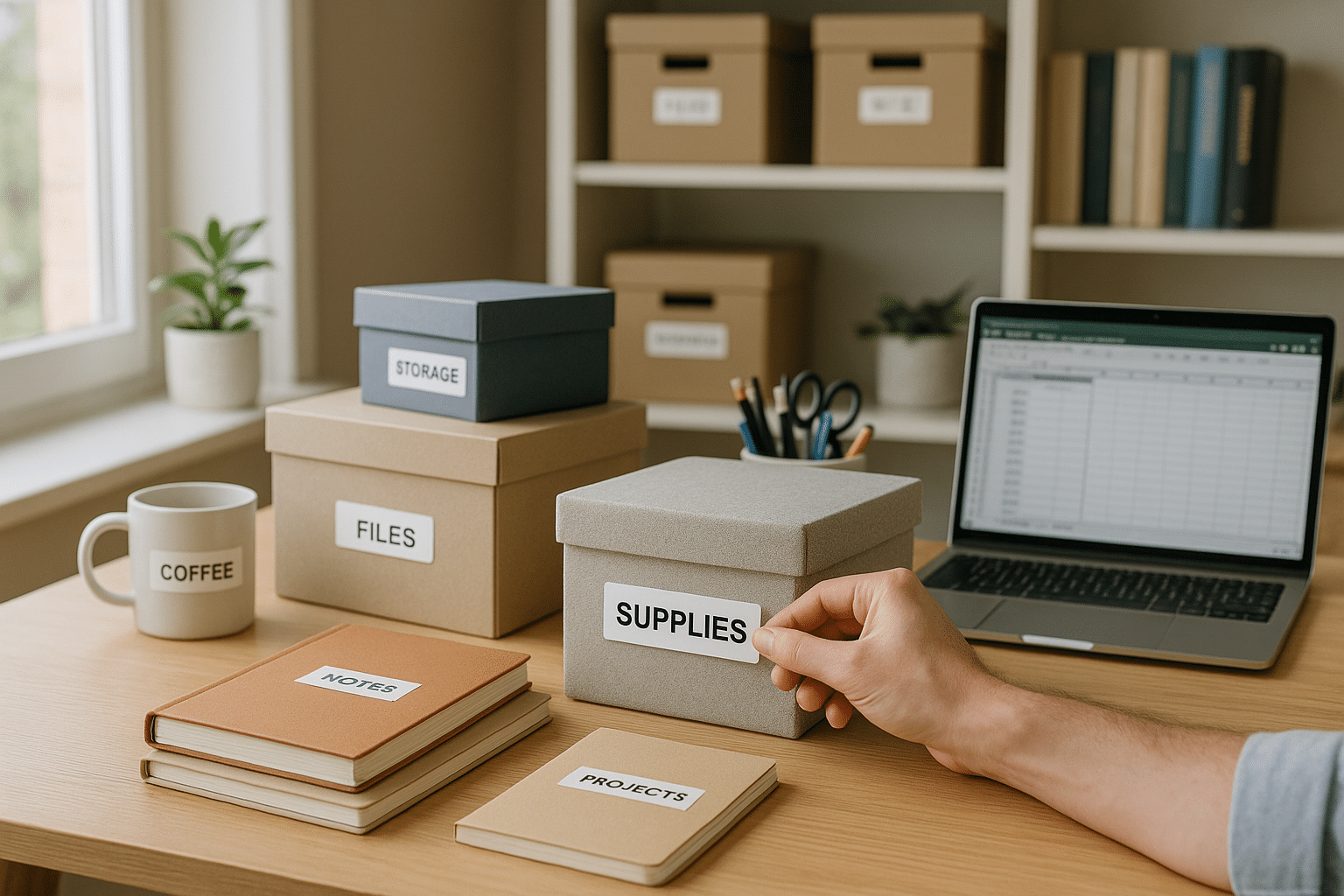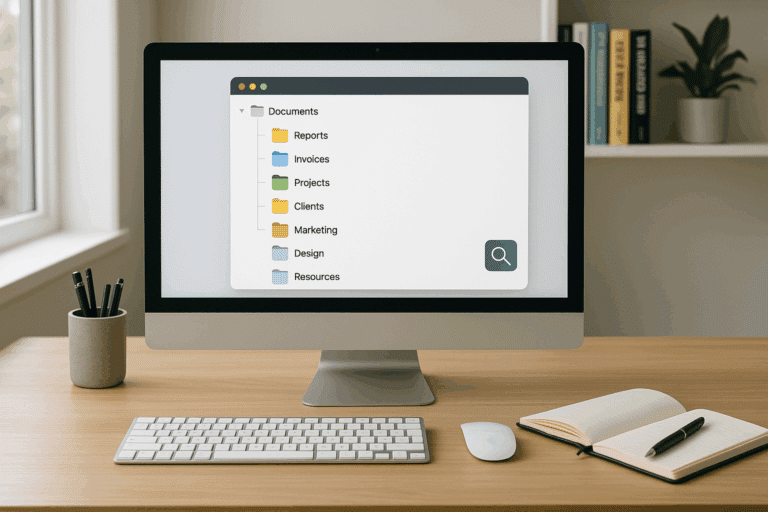In today’s digital landscape, where information is vast and varied, keeping track of your data can be a daunting task. As the volume of data we deal with increases, the need for efficient ways to manage and organize them becomes more critical. This is where the art of tagging and labeling steps in. 🏷️💻🗂️
Think of the last time you tried to find a specific email in your overflowing inbox or a particular document in your chaotic cloud storage. Was it easy? Or did you wish you had some sort of system in place to help you retrieve what you needed faster?
Imagine having a neat and orderly digital environment where everything is just a click away. Well, that’s precisely what we’re going to delve into in this comprehensive guide: the ultimate method of staying organized with tags and labels. 📚🔍👌
We’re going to explore the power of tags and labels to turn your digital world into an oasis of order and accessibility. You’ll learn how to streamline your data, making it easily retrievable and shareable. We’ll delve into the strategies and best practices for implementing tags and labels effectively across various platforms and applications. And yes, we’ll even touch on the right etiquettes of tagging and labeling, because, let’s face it, too much of anything can become overwhelming. 😅🏷️🔖
Whether you’re a tech-savvy professional juggling multiple projects, a business owner aiming for efficient operations, or a homemaker striving to keep things tidy and organized, this guide is your ticket to a more streamlined, organized digital life. 😊💼🏠
Exciting, right? But before we start our journey into the world of tags and labels, it’s crucial to understand what they are and their significance in our digital life. Without further ado, let’s get started. 🚀🌐💡
The Power of Tags and Labels: Breaking Down the Basics 🏷️🔖
In this section, we’ll unravel the true meaning of tags and labels, their various types, and the roles they play in digital organization. We’ll also address some common misconceptions about these organizational tools and how you can leverage them for maximum efficiency.
Tags and Labels in Action: Real-Life Applications 💼🏠🎯
Ever wondered how to put tags and labels to practical use? Here, we’ll illustrate how these tools can be employed in real-life scenarios. We’ll take you through a variety of applications, including managing emails, organizing files, tracking projects, and even planning events!
Tagging and Labeling Strategies: Best Practices for Optimal Organization 💡🏷️🔖
Ready to get your digital life in order? This section is all about providing you with effective strategies and best practices to take your tagging and labeling game to the next level. From choosing the right tags and labels to maintaining them, we’ve got you covered.
So, are you ready to embark on this journey of digital organization and efficiency? Let’s dive in and unlock the power of tags and labels together! 👩💻👨💻🚀
🎯 Initiate a New Era of Organization with Tags and Labels
In our rapidly advancing digital world, staying organized can be quite a challenge. It’s not just about keeping our physical spaces tidy anymore. Now, we’re also tasked with organizing a growing heap of digital data. Enter tags and labels, your ultimate tools for bringing order to digital chaos. With the right strategies, these tools can streamline your workflow, enhance your productivity, and make your life a whole lot simpler.
Before diving into these strategies, let’s start by clearing up a common confusion: What is the difference between a tag and a label? Essentially, labels are broader categories used to classify data, while tags are more specific descriptors. For instance, in your email inbox, a label might be “Work”, while a tag could be “Project X”. You could have multiple emails under the “Work” label, and then use tags like “Project X” to further organize them.
Now that we’ve cleared up that confusion, let’s delve into the specifics of how to effectively use tags and labels in your digital life. From categorizing emails to organizing files, we will provide a comprehensive guide to help you navigate this important aspect of digital organization.
💼 Tagging and Labeling for Work: A Game-Changer for Productivity
When it comes to your professional life, tags and labels can be a game-changer. They can help you manage your emails, organize your projects, and keep track of your tasks. Let’s take a look at how to use these tools effectively in a work context.
📧 Email Management with Labels
One of the biggest culprits of disorganization in the workplace is the email inbox. Overflowing with messages, it can quickly become a source of stress and confusion. Luckily, labels are here to save the day. By labeling your emails based on categories such as project, client, or urgency, you can easily sort and prioritize your messages. For instance, in Gmail, you can create custom labels and even color-code them for added visibility.
Once you’ve labeled your emails, you can use tags to further classify them. For example, you could tag emails related to a specific task under a project, or tag them based on their priority (“urgent”, “later”, etc.). This way, you can quickly find what you’re looking for without having to sift through a pile of emails.
📁 Project Organization with Tags
When it comes to project management, tags can be incredibly helpful. They allow you to categorize tasks, files, and discussions, making it easier to find and access relevant information. For example, you could tag a task with the project’s name, the responsible person’s name, and the deadline. This way, anyone involved in the project can easily see what needs to be done, who’s responsible, and when it’s due.
In project management tools like Trello or Asana, you can use tags to filter tasks and keep your projects organized. You can even use multiple tags for a single task, providing a detailed overview of what the task involves.
🏠 Using Tags and Labels for Personal Organization
Tags and labels aren’t just for work—they can also be a lifesaver when it comes to personal organization. Whether it’s managing your personal emails, organizing your digital files, or keeping track of your to-dos, these tools can help you keep your digital life in check.
📬 Personal Email Management
Much like in a work context, labels and tags can be a great way to organize your personal emails. For instance, you could label emails based on their source (friends, family, subscriptions, etc.) and then use tags to further categorize them (events, bills, travel plans, etc.). This way, you can easily find the email you’re looking for, without having to scroll through your entire inbox.
In addition to helping you stay organized, this strategy can also help you stay on top of your responsibilities. For instance, by tagging emails related to bills or appointments, you can make sure you don’t miss any important dates or deadlines.
🗂 Digital File Organization
As we move towards a more digital lifestyle, the amount of digital files we accumulate is increasing rapidly. Photos, documents, music files—the list goes on. Without a proper organization system, finding a specific file can be like looking for a needle in a haystack. Luckily, tags and labels can make this process a lot easier.
By labeling folders based on broad categories (Work, Personal, Finance, etc.) and then tagging files with more specific descriptors (Project X, Vacation Photos, Tax Returns, etc.), you can create a structured system that makes finding your files a breeze.
To illustrate the power of tags and labels, let’s look at a comparative table. Suppose you have two digital photo collections: one organized with tags and labels, and one without.
| Photo Collection | Time Spent Searching for a Specific Photo |
| Without Tags and Labels | 30 minutes |
| With Tags and Labels | 1 minute |
The difference is clear: with tags and labels, you can save a significant amount of time and effort. But how do you get started? Check out this helpful YouTube video for a step-by-step guide on how to organize your digital files with tags and labels: “How to Use Tags to Organize Files and Folders on Your Mac” by the channel “Tech Talk America”.
💡 Best Practices for Using Tags and Labels
While tags and labels can be incredibly useful, they’re only effective if used properly. Here are some best practices to ensure you’re making the most of these tools.
🏷 Consistency is Key
When using tags and labels, it’s crucial to be consistent. Stick to a naming convention and use it across all platforms. This will make it easier to remember your tags and labels, and it will also ensure that you can find what you’re looking for, no matter where it’s stored.
📈 Keep it Simple
While it can be tempting to create a tag or label for every possible category, this can quickly lead to clutter and confusion. Instead, keep it simple. Stick to broad categories for labels, and use tags for more specific descriptors. If you find that you have too many tags or labels, it may be time to rethink your organization system.
🔄 Regular Maintenance
Like any organization system, tags and labels require regular maintenance. Make it a habit to review your tags and labels periodically and update them as necessary. This will help you stay organized and ensure that your system continues to be effective.
Whether you’re looking to streamline your workflow, stay on top of your tasks, or simply bring order to your digital chaos, tags and labels can be a powerful tool. By implementing these strategies and best practices, you can start reaping the benefits of these tools today. So, why wait? Start tagging and labeling, and experience a new level of digital organization.
🔑 Unlock the Power of Tags and Labels: Key Takeaways
- Tags and labels are powerful tools for digital organization, helping you manage your emails, organize your tasks, and keep track of your files.
- In a work context, labels can be used to categorize emails, while tags can provide more specific descriptors. Tags can also be useful for project management, allowing you to categorize tasks, files, and discussions.
- For personal organization, labels and tags can be used to manage personal emails and organize digital files.
- When using tags and labels, it’s important to be consistent, keep it simple, and perform regular maintenance.
In conclusion, tags and labels can truly be a game-changer for digital organization. By harnessing the power of these tools, you can streamline your workflow, enhance your productivity, and enjoy a more organized digital life.

Conclusion
In conclusion, the importance of the subject matter discussed in this article cannot be overstated. From the basics of IT and engineering to the intricacies of software engineering, we have delved into the complexities of these areas and sought to simplify them for better understanding.
The field of IT and engineering is not only expansive but also ever-evolving. Therefore, staying up-to-date with current trends, techniques, and technologies is an absolute must for anyone in the industry. As we have seen, the software engineering process involves several stages: requirements gathering, system design, coding, testing, maintenance, and so on. This is no easy task, but by understanding each step and its importance, one can approach the process with a more informed and effective strategy.
Moreover, we have stressed the crucial role of a technical writer in making such complex information understandable for all parties involved, from the software engineers to the end users. It is through clear and concise communication that we can bridge the gap between technical expertise and user experience. 📝💻
Furthermore, we have explored the growing importance of software engineering in today’s digital age. With an increasing reliance on technology in almost all aspects of life, the demand for skilled software engineers is at an all-time high. Hence, it is safe to say that this is a field with vast opportunities for growth and innovation. 🚀🌐
While the concepts and processes we have discussed may seem daunting, it is our hope that this article has provided you with a clearer understanding and renewed interest in IT and engineering. Do not be discouraged if you do not grasp everything at once. Remember, learning is a continuous process, and every bit of knowledge gained is a step towards mastery. 🎓⏳
We invite you to share this article with colleagues and friends who may also find it beneficial. Comments and suggestions are always welcome, as they contribute to the continuous improvement and expansion of our content. If there are specific topics you would like us to cover in future articles, please let us know.
To learn more about software engineering, we recommend the following active resources:
– The Institute of Electrical and Electronics Engineers (IEEE) Software Engineering page (https://www.computer.org/technical-committees/software-engineering/)
– Association for Computing Machinery (ACM) Software Engineering page (https://www.acm.org/special-interest-groups/sigs/sigsoft)
– Google Scholar for scholarly articles on software engineering (https://scholar.google.com/)
As always, thank you for your time and attention. We look forward to continuing this educational journey with you. Remember, knowledge is power. Keep learning, keep growing, and keep innovating. Until next time, happy reading! 📚🌟



